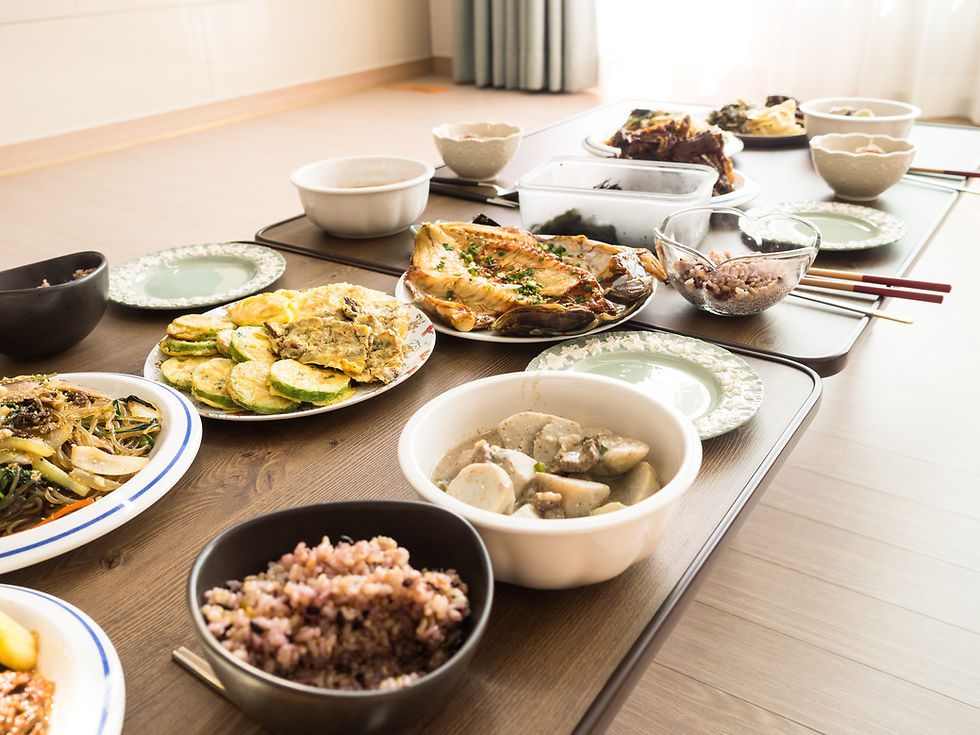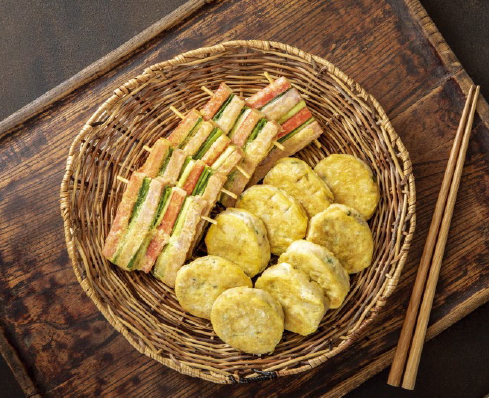5 Traditional Korean Holiday Foods You Need to Try for Chuseok and Seollal
- Korea Tourism Organizaon

- Sep 7, 2024
- 4 min read

The Meaning of Korean Holidays
Chuseok is one of Korea’s three major holidays, along with Seollal (Lunar New Year’s Day) and Dano (the 5th day of the 5th lunar month). Chuseok is also referred to as hangawi. Han means “big” and gawi means “the ides of the 8th lunar month or autumn.” According to the lunar calendar, the harvest moon, the largest full moon of the year, appears on the 15th day of the eighth month.

Why Food Is Central to Korean Celebrations
During traditional holidays in Korea, the whole family gathers together and makes special foods to place on the table for the ancestral memorial ceremony. These foods serve to unite the family unit, with each food having a special meaning such as happiness, longevity, or financial success. To celebrate these holidays like a Korean, try making one of these traditional Korean holiday foods and sharing with your family!

Jeon – Savory Korean Pancakes for Every Occasion
Jeon is a savory pancake made by coating the ingredients of choice with a light flour batter and then frying it in a pan with some oil. The ingredients used will completely change the taste. A variety of jeon can be seen during Korea’s holiday seasons, but you are almost guaranteed to see kimchi jeon (kimchi pancake), haemul pajeon (seafood and green onion pancake), gogiwanja jeon (pan-fried battered meat balls), kkochi jeon (pancake skewer), and gamja jeon (potato pancake).

Outside of the holiday period, if you want to try some delicious jeon, head to a jeon specialty street. Near Hoegi Station on Seoul Subway Line 1, you can find plenty of restaurants selling thick haemul pajeon on Hoegi Station Pajeon Street. For a range of jeon, visit Mapo Jeon Street, located near Gongdeok Station on Seoul Subway Lines 5 & 6.

Japchae – A Festive Dish of Noodles and Vegetables
Japchae is yet another dish that is often present during festive days in Korea. Japchae is a compound word of the Korean words “jap” meaning mix, and “chae,” from “chaeso” which means vegetable. In reality, japchae also includes meat, mushrooms, and glass noodles, and is stir-fried with a soy sauce-based marinade.
While the ingredients complement each other when mixed together, they must first be chopped and fried separately, requiring a lot of work. While parents prepare the japchae, it is not uncommon to see their children waiting around for a bite of the tasty dish.

Mandu – Korean Dumplings for Seollal
Mandu are dumplings made of a flour-based shell filled with a range of minced ingredients such as meat, vegetables, or kimchi. In addition to the range of possible fillings, mandu can also be prepared in a few different ways: in a soup, boiled, steamed, or fried.
On Seollal (Lunar New Year’s Day), many families add mandu to their bowl of tteokguk (sliced rice cake soup). The ingredients go well together, and mandu was used as a symbol representing the wish for a peaceful new year during memorial services.
There are many mandu specialties throughout the country. In Seoul, Jaha Sonmandu, included in the 2024 Michelin Guide makes a hearty mandu soup, while Wonju’s Wonju Kimchi Mandu has famously plump kimchi mandu, and Daegu’s Miseongdang offers flat mandu filled with just glass noodles and chives.

Tteokguk – Rice Cake Soup for the New Year
On the morning of Seollal, Koreans make a wish for the New Year, greet their elders, and eat tteokguk (sliced rice cake soup)!
While there are slight variations by region, the standard tteokguk is made by cutting a long rice cake stick into thin slices and then boiling them in a beef broth.
Before serving, the soup is topped with egg garnish and seaweed flakes. The white rice cakes and broth represent starting out the New Year with a clean slate, while the long rice cake stick and round slices symbolize longevity and prosperity.
Koreans will also say “I ate one bowl of tteokguk” to say they got one year older, as Koreans previously counted ages as starting on the first day of the year.

Songpyeon – Chuseok’s Signature Rice Cake
When talking about Chuseok, songpyeon is the first food that comes to mind. Songpyeon is a type of rice cake made during Korea’s harvest period with the year’s new grain. The rice cakes are placed on the charyesang (ancestral rites table) as a symbol of thanks for the results of the year.
Although families in the past would gather and share their well-wishes for each other while making these rice cakes, these days many families buy them pre-made from rice cake shops. The rice cake is made using a dough of freshly harvested rice, filled with beans, red beans, sesame, chestnuts, or other nutritious ingredients and then steamed. The rice cakes get their name and signature scent from being steamed over a bed of pine needles (“song” means pine in Korean).
Celebrate Together With Traditional Korean Holiday Foods
Korean holidays are about more than just marking the passage of time—they are about family, tradition, and the joy of sharing a meal. From the savory crunch of jeon to the sweet, pine-scented bite of songpyeon, each dish carries meaning and connects generations around the table. These traditional Korean holiday foods aren’t just delicious; they represent wishes for happiness, longevity, and prosperity.
Whether you’re celebrating Chuseok, Seollal, or simply curious about Korean culture, trying these dishes is a way to experience the heart of Korea’s traditions. So gather your loved ones, prepare a few of these festive foods, and create your own memories around the table—just as Korean families have done for centuries.




Comments